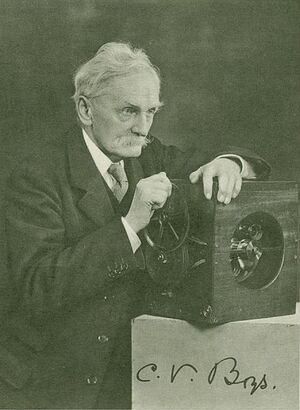C. V. Boys (nonfiction)
Sir Charles Vernon Boys, FRS (15 March 1855 – 30 March 1944) was a British physicist, known for his careful and innovative experimental work.
Early life
Boys was the eighth child of the Reverend Charles Boys, the Anglican vicar of Wing, Rutland. He was educated at Marlborough College and the Royal School of Mines, where he learned physics from Frederick Guthrie and taught himself higher mathematics while completing a degree in mining and metallurgy. As a student at the School of Mines he invented a mechanical device (which he called the integraph) for plotting the integral of a function. He worked briefly in the coal industry before accepting Guthrie's offer of a position as "demonstrator."
Experimental physics
Boys achieved recognition as a scientist for his invention of the fused quartz fibre torsion balance, which allowed him to measure extremely small forces. He made the fused quartz fibres for his instrument by attaching a quartz rod to a crossbow quarrel, heating the rod to the point of melting, and firing the crossbow. By this means he produced fibre so thin that it could not be resolved with an optical microscope. He used this invention to build a radiomicrometer capable of responding to the light of a single candle more than one mile away, and used that device for astronomical observations. In 1895 he published a measurement of the gravitational constant G that improved upon the accuracy achieved by Cavendish. Boys' method relied on the same theory as Cavendish's, but used two masses suspended at one height and two nearby masses suspended at a different height, to minimize the unwanted interaction between opposite masses.
He was a critic of the solar design of Frank Shuman, so Shuman hired him, and together they patented a "Sun-Boiler", which is similar to modern day parabolic trough solar power plants.
Public service and educational work
In 1897 Boys became a Metropolitan Gas Referee, charged with assessing a fair price for coal gas. He initially worked on the replacement of the standard candle, used to determine the quality of the gas for lighting, by the Harcourt pentane lamp. As heating grew to become the principal use of coal gas, Boys undertook fundamental work on calorimetry to measure and record the heat content of the gas, achieving a substantial increase in precision of measurement. At this time the national gas bill for the United Kingdom was fifty million pounds, so a one-percent correction to the bill represented a very significant amount of money.
Boys also worked on high-speed photography of lightning and bullets in flight, and conducted public lectures on the properties of soap films, which were gathered into the book Soap Bubbles: Their Colours and the Forces Which Mould Them, a classic of scientific popularisation. The first edition of Soap Bubbles appeared in 1890 and the second in 1911; it has remained in print to this day. The book deeply impressed French writer Alfred Jarry, who in 1898 wrote the absurdist novel Exploits and Opinions of Dr. Faustroll, Pataphysician, in which the title character, who was born at the age of 63 and sails in a sieve, is described as a friend of C.V. Boys (see also Pataphysics). The book was also a favorite of American poet, Elizabeth Bishop.
Recognition
Boys was an assistant professor at the Royal College of Science (now Imperial College London) in South Kensington from 1889 to 1897, as well as an examiner at the University of London. In 1899 he presented the Royal Institution Christmas Lectures. He was elected to the Royal Society in 1888 and knighted in 1935. He was awarded the Royal Medal in 1896 and the Rumford Medal in 1924. He was awarded the Elliott Cresson Medal in 1939.
Other Positions held
- President of the Physical Society 1916–17
- President of the Rontgen Society 1906–07
Personal life
Boys married Marion Amelia Pollock in 1892. A scandal occurred following her affair with the Cambridge mathematician Andrew Forsyth, as a result of which Forsyth was forced to resign his chair. Boys divorced Marion in 1910 and she later married Forsyth.
He died at St Mary Bourne, Andover in Hampshire on 30 March 1944.
References
- O'Connor, John J.; Robertson, Edmund F., "C. V. Boys", MacTutor History of Mathematics archive, University of St Andrews.
- Rayleigh, B. (1944). "Charles Vernon Boys. 1855–1944". Obituary Notices of Fellows of the Royal Society. 4 (13): 771. doi:10.1098/rsbm.1944.0021.
- "On the Newtonian Constant of Gravitation" (PDF). Nature. 50 (1292): 330. August 1894. Bibcode:1894Natur..50..330.. doi:10.1038/050330a0.
- Ragheb, Magdi (10 September 2014). "Solar Thermal Power and Energy Storage Historical Perspective" (PDF). mragheb.com. Retrieved 25 October 2018.
- Uman, Martin A. (1984) [1969]. Lightning. New York: Dover Publications Inc. pp. 15–18. ISBN 0-486-15095-X.
- Waterston, C. D.; Shearer, A. Macmillan (July 2006). "Former Fellows 1783 – 2002" (PDF). The Royal Society of Edinburgh.
External links
- Works by C. V. Boys at Project Gutenberg
- Works by or about C. V. Boys at Internet Archive
In the News
Fiction cross-reference
Nonfiction cross-reference
- Calorimetry (nonfiction) - the science or act of measuring changes in state variables of a body for the purpose of deriving the heat transfer associated with changes of its state due, for example, to chemical reactions, physical changes, or phase transitions under specified constraints.
- Candlepower (nonfiction) - an obsolete unit of measurement for luminous intensity. It expresses levels of light intensity relative to the light emitted by a candle of specific size and constituents. The historical candlepower is equal to 0.981 candelas. In modern usage, candlepower is sometimes used as a synonym for candela.
- Gravitational constant (nonfiction) - an empirical physical constant involved in the calculation of gravitational effects in Sir Isaac Newton's law of universal gravitation and in Albert Einstein's general theory of relativity.
- Integraph (nonfiction) - a mechanical analog computing device for plotting the integral of a graphically defined function.
- Physics (nonfiction)
External links
- C. V. Boys @ Wikipedia
